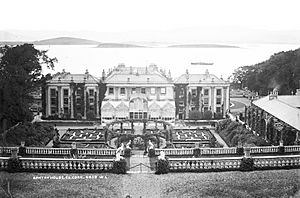Bantry House facts for kids
Quick facts for kids Bantry House |
|
|---|---|

Bantry House and Bantry Bay
|
|
| General information | |
| Architectural style | Queen Anne with Georgian and Victorian additions |
| Town or city | Bantry |
| Country | Ireland |
| Coordinates | 51°40′37″N 9°27′54″W / 51.677°N 9.465°W |
| Completed | c.1710 (original house) c.1820 (additions) c.1845 (wings) |
Bantry House is a beautiful old house with amazing gardens in Bantry, County Cork, Ireland. It was built a long time ago, in the early 1700s. The White family has lived there since the mid-1700s. Today, Bantry House, its land, and its gardens are a popular place for tourists to visit in West Cork. It has been open to the public since the 1940s.
History of Bantry House
Bantry House was first built around 1710. It was originally called 'Blackrock'. It stands on the south side of Bantry Bay. In 1750, a man named Councillor Richard White bought Blackrock. He then changed its name to 'Seafield'.
The White family had moved to Whiddy Island in the late 1600s. They were originally merchants from Limerick. The family became very successful. They bought a lot of land around the house. By the 1780s, Bantry House owned about 80,000 acres. However, much of this land was not good for farming.
Bantry House has welcomed visitors since 1946. In 2012, the house was featured on a TV show called Country House Rescue.
Exploring the Gardens
The beautiful gardens at Bantry House were created by Richard White, 2nd Earl of Bantry and his wife Mary. The gardens are designed with seven different levels, called terraces. The main house itself is located on the third terrace.
Behind the house and a fountain, there are one hundred steps. These steps are surrounded by colorful azaleas and rhododendrons.
By 1997, some parts of the Bantry House grounds needed repair. A special grant from Europe helped start the restoration work. This funding ended in 2000. However, more grants were received from the Irish government in 2022 and 2023. As of summer 2024, the work to restore the gardens was still happening.
The Armada Centre Exhibition
An exhibition about the United Irishmen Rebellion was opened at Bantry House. It was set up in the house's courtyard. This exhibition focused on the French attempt to invade Ireland in 1796. It also showed the important role of Richard White. He owned the house at the time and helped stop the invasion.
The French ships never actually landed. Bad weather caused several ships to sink. One of these was the frigate Surveillante. The Armada Centre had a small model of the Surveillante. It also displayed items found from its shipwreck.
See also
 In Spanish: Bantry House para niños
In Spanish: Bantry House para niños
- Earl of Bantry
- Historic Cork Gardens
- West Cork Chamber Music Festival


